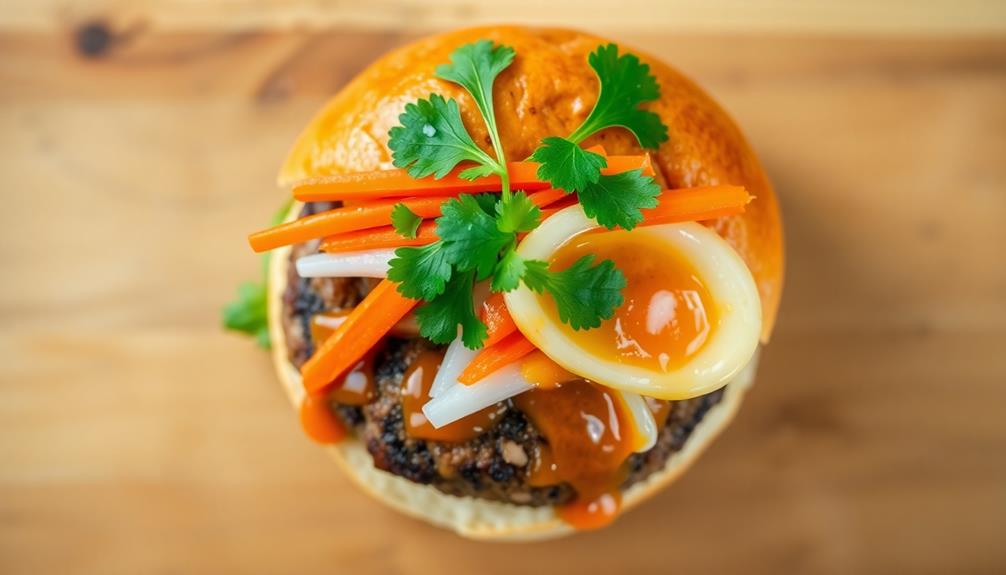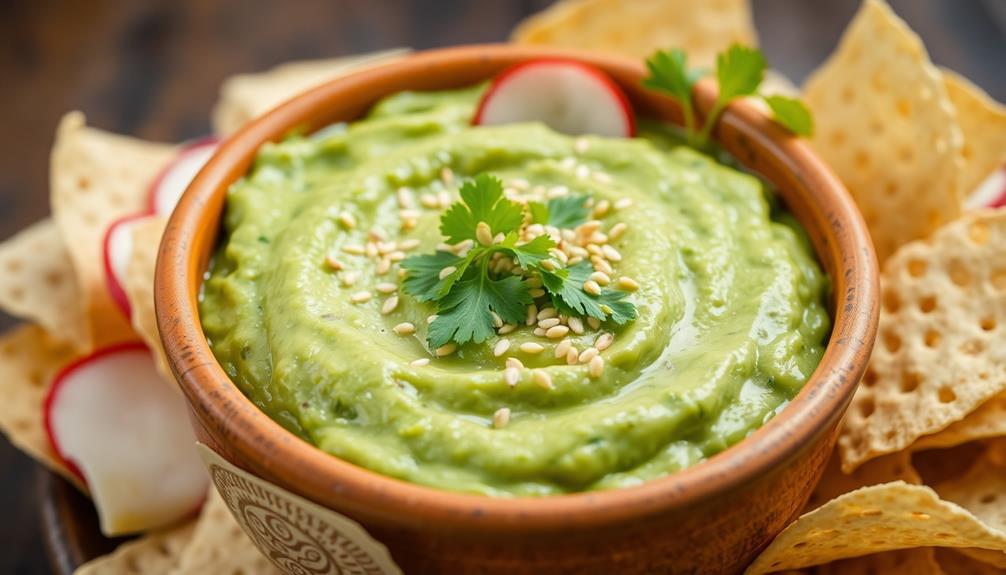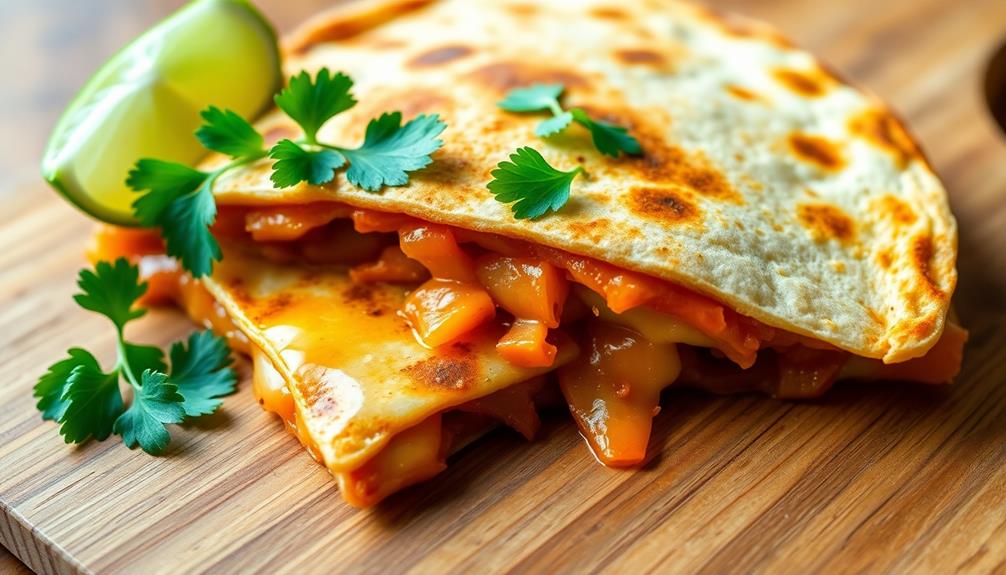You're in for a real treat with the Banh Mi Burger! This mouthwatering creation blends the savory flavors of an American classic with the bright, aromatic ingredients of the iconic Vietnamese banh mi sandwich. You'll enjoy the soft, toasted brioche bun, seasoned beef patty, and crunchy toppings like pickled veggies and fresh cilantro. The zesty Sriracha mayo adds the perfect spicy kick. It's a harmonious fusion of cultures that'll tantalize your taste buds. Get ready to discover this delightful culinary mashup and so much more. But that’s not all – this burger takes it a step further by incorporating pork fu ingredients and flavors, introducing a light, savory touch that perfectly complements the beef. Each bite offers a delightful contrast between tender meat and crispy, airy pork fu, making the experience even more irresistible. It’s the perfect combination of textures and tastes that elevates this unique fusion dish to the next level.
Key Takeaways
- The Banh Mi Burger is a fusion of Vietnamese and French culinary traditions, with a baguette base and savory Vietnamese fillings.
- The recipe combines burger flavors with bright Vietnamese components, balancing various ingredients for flavor and presentation.
- The dish represents a growing trend in global culinary innovation, blending flavors and textures from both Vietnamese and American cuisines.
- The Banh Mi Burger is gaining popularity in food trucks, casual dining, and fusion cuisine restaurants across the globe.
- The Banh Mi Burger can be paired with Asian-inspired sides and beverages, and customized with various toppings for personalized flavors.
History
The origins of the banh mi burger can be traced back to the fusion of Vietnamese and French culinary traditions. When the French colonized Vietnam in the 19th century, they introduced bread and other baking techniques. This led to the creation of the classic banh mi sandwich, which combined the French-style baguette with savory Vietnamese fillings like pork, pickled vegetables, and fragrant herbs.
Fast forward to modern times, and creative chefs have taken the beloved banh mi and reimagined it as a delicious burger. By replacing the traditional baguette with a soft, pillowy bun and layering on classic banh mi ingredients, they've crafted a unique and satisfying fusion dish.
The banh mi burger beautifully blends the bold, bright flavors of Vietnamese cuisine with the comfort and familiarity of an American classic. It's a culinary adventure that celebrates the rich cultural exchange between these two beloved food traditions.
Recipe
A Banh Mi Burger is a delightful fusion of Vietnamese and American cuisine. This dish combines the savory flavors of a juicy burger with the bright and tangy components of a traditional Vietnamese banh mi sandwich. The result is a unique and satisfying culinary experience that's sure to delight your taste buds.
The key to a successful Banh Mi Burger lies in the balance of its various elements. By carefully selecting the right ingredients and following a few simple steps, you can create a burger that's both visually appealing and bursting with flavor.
Ingredients:
- 1 lb ground beef
- 1 teaspoon garlic powder
- 1 teaspoon onion powder
- 1 teaspoon salt
- 1/2 teaspoon black pepper
- 4 brioche buns, split
- 1 cup shredded carrots
- 1 cup thinly sliced cucumber
- 1/2 cup pickled daikon radish
- 1/4 cup fresh cilantro leaves
- 2 tablespoons mayonnaise
- 2 tablespoons Sriracha sauce
In a large bowl, gently combine the ground beef, garlic powder, onion powder, salt, and black pepper until just mixed. Form the mixture into four equal-sized patties.
Heat a large skillet or grill pan over medium-high heat and cook the patties for 3-4 minutes per side, or until cooked through. Toast the brioche buns until lightly golden.
To assemble the Banh Mi Burgers, spread a thin layer of mayonnaise on the bottom buns, followed by the beef patty.
Top with the shredded carrots, sliced cucumber, pickled daikon radish, and fresh cilantro leaves. Drizzle the Sriracha sauce over the top and close the burgers with the top buns.
Serve immediately and enjoy the perfect blend of flavors and textures.
Cooking Steps
First, you'll mix up a tasty mayo-Sriracha-lime juice sauce.
Then, use your hands to form the patties and get 'em sizzling on the grill until they're cooked through.
Finally, you'll pile on all the classic banh mi fixings and serve it up on a toasted baguette.
Get ready for an explosion of flavor in every bite!
Step 1. Mix Mayo, Sriracha, Lime Juice
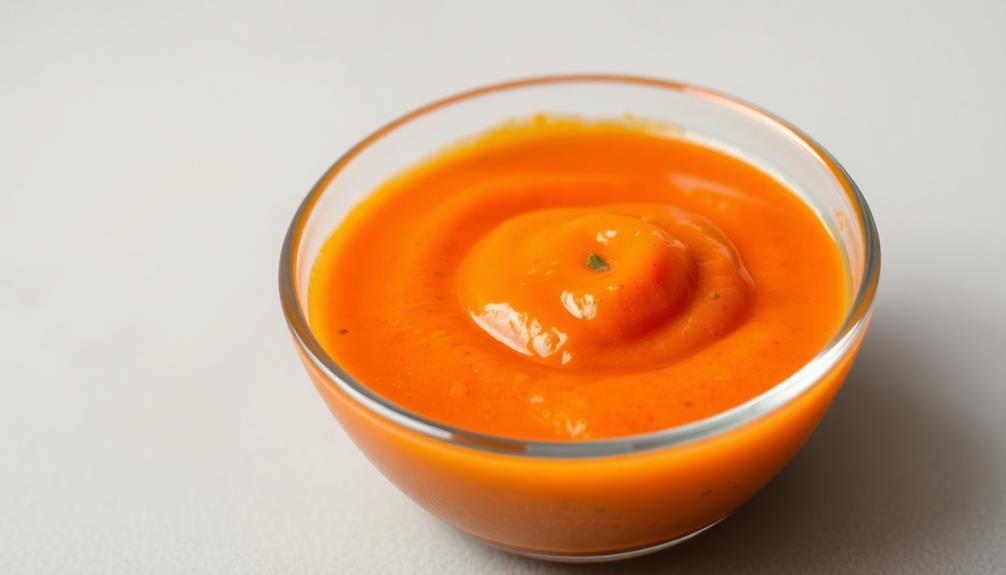
Mix the mayonnaise, Sriracha, and lime juice in a small bowl until well combined. The tangy and creamy mixture will be the perfect topping for your Banh Mi Burger.
You'll want to make sure the flavors are nicely balanced – not too spicy, not too sour. Taste it as you go and adjust the ingredients to your liking.
Once you've got the sauce ready, it's time to start assembling the burgers. Spread a generous amount of the mayo-Sriracha mixture on the toasted buns.
This zesty sauce will complement the savory patty and crunchy veggies. The lime juice gives it a bright, fresh kick that ties all the flavors together.
Don't be shy with the sauce – drizzle it on generously! The cool creaminess will balance out the heat from the Sriracha.
And the tangy lime will make every bite of your Banh Mi Burger absolutely bursting with flavor.
Step 2. Form Patties
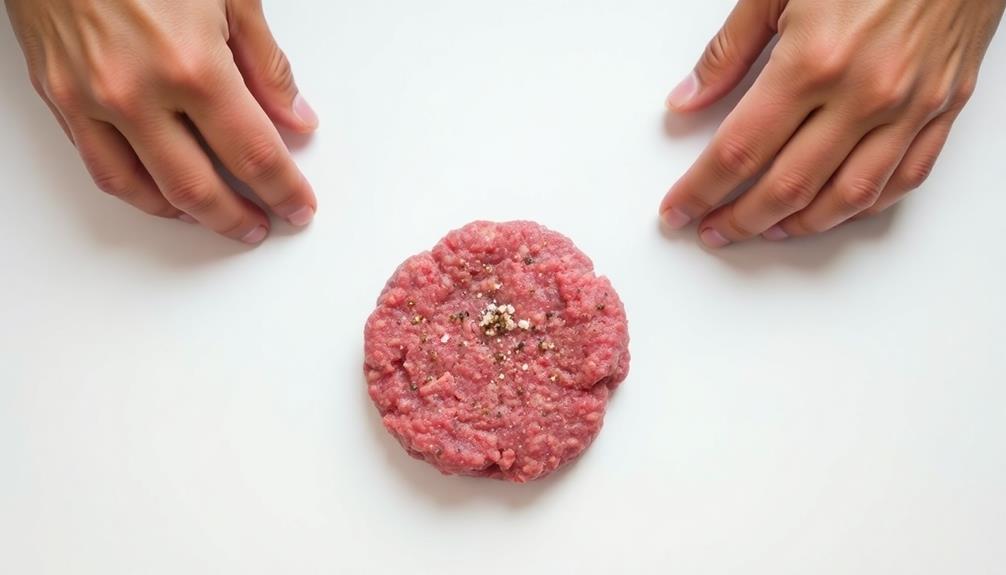
Grab a handful of the ground beef and gently shape it into evenly-sized patties, being careful not to overwork the meat. Use your hands to lightly press and mold the beef, creating patties that are about 4 inches wide and 1/2 inch thick. This will help them cook quickly and evenly.
Don't pack the patties too tightly – you want them to be nice and tender when you bite into them. Gently round the edges with your fingers to get a nice shape.
Once you've formed all the patties, you're ready for the next step. Get ready to cook up some delicious Banh Mi Burgers!
The key is to handle the beef as little as possible. Overworking the meat can make the patties tough and dense. With just a few gentle motions, you'll have perfectly shaped burger patties that'll sizzle and char beautifully on the grill or in the pan.
Now you're one step closer to stacking up that tasty Vietnamese-inspired masterpiece.
Step 3. Grill Patties Until Cooked Through
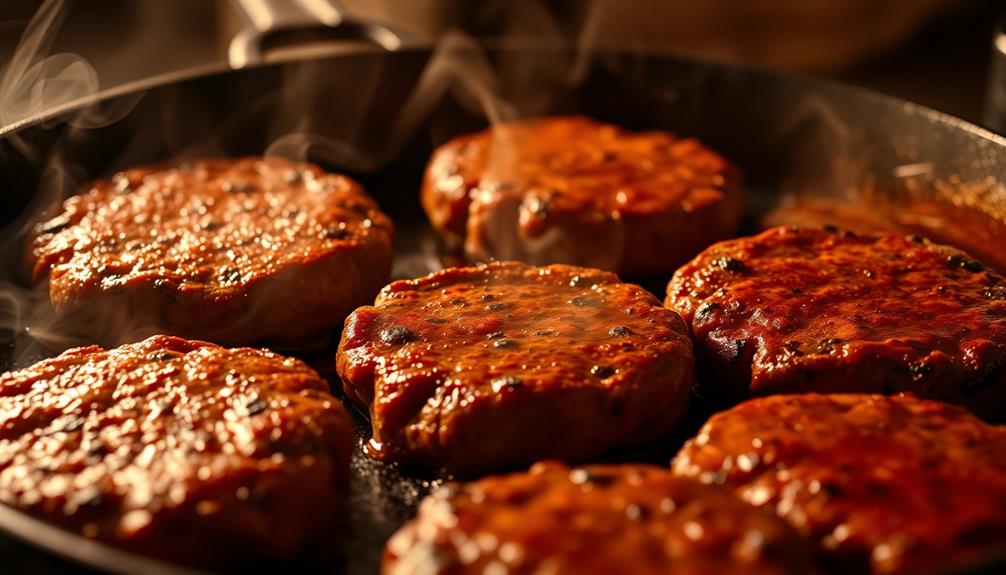
With the patties formed, it's time to cook them up. Grab your trusty grill and preheat it to a medium-high heat. You want that grill nice and hot, ready to sear those patties to perfection.
Carefully place the patties onto the grill, making sure they've enough space between them. Let them sizzle and brown on the first side, about 4-5 minutes. You'll know they're ready to flip when you can easily slide a spatula underneath.
Flip the patties over and let them cook for another 4-5 minutes on the second side. Keep a close eye on them, adjusting the heat if needed to prevent burning.
You're looking for the patties to be cooked all the way through, with no more pink in the center. Once they reach your desired doneness, remove the patties from the grill and set them aside.
They're one step closer to becoming the ultimate Banh Mi Burger!
Step 4. Assemble Banh Mi Components

To assemble the Banh Mi components, start by toasting the buns. Run them briefly under the broiler or toast them in a dry skillet over medium heat. This'll give them a lovely crunch.
Next, spread some mayo on the buns – just a thin layer to add moisture and richness.
Now, it's time for the star of the show – the grilled patty. Place it on the bottom bun, then add a generous amount of slivered carrot and daikon. These crunchy, pickled veggies are a must for authentic banh mi flavor.
Don't forget the fresh herbs! Sprinkle on some cilantro leaves and sliced jalapeño for a pop of color and zing.
Step 5. Serve on Toasted Baguette
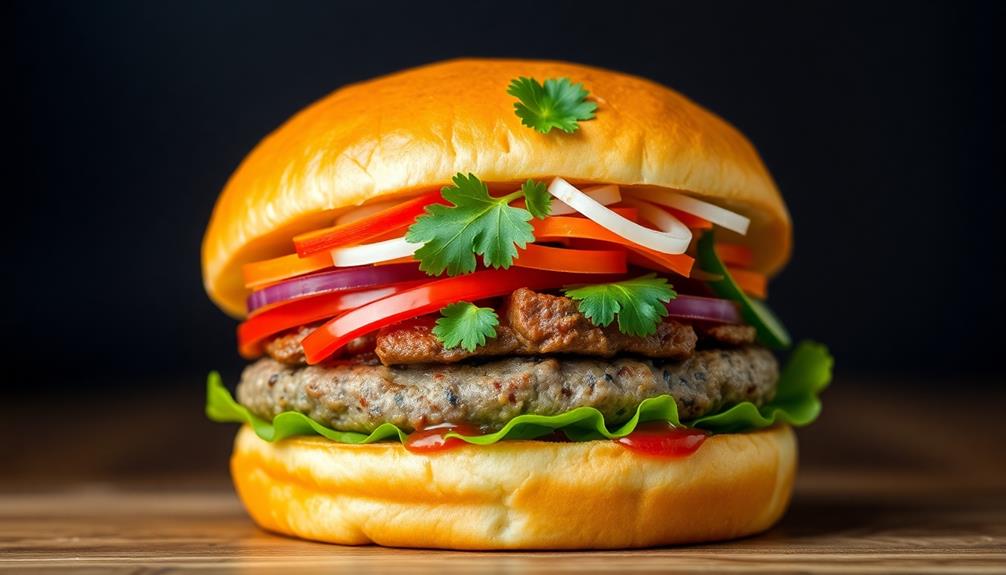
Why not start by slicing the baguette in half lengthwise? This'll create two slices that you can toast to a nice golden brown.
You'll want that crispy exterior to hold up to all the tasty fillings you're about to add.
Once your bread's toasted, it's time to start layering on the good stuff. Smear a generous amount of the quick-pickled carrots and daikon radish mixture onto the bottom slice.
These bright, tangy veggies are a signature component of the banh mi.
Next, add a few slices of the juicy grilled beef patty. Don't be shy – stack it on!
Top that with a few sprigs of fresh cilantro and a drizzle of the spicy sriracha mayo. The cool, creamy sauce pairs perfectly with the heat.
Final Thoughts
Ultimately, the Banh Mi Burger is a delightful fusion of Vietnamese and American culinary traditions. You'll be amazed by how the zesty flavors of the Vietnamese sandwich meld seamlessly with the classic burger. The crunchy, toasted baguette provides the perfect base, while the savory beef patty, tangy pickled vegetables, and fragrant cilantro come together in every bite.
What really sets this burger apart is the balance of textures. The crisp, fresh veggies contrast with the tender meat, creating a sensational mouthfeel.
And the fragrant lemongrass and warm spices infuse every component with aromatic delight. Whether you're a fan of Vietnamese cuisine or simply love a good burger, the Banh Mi Burger is sure to impress.
It's a culinary adventure that celebrates the best of both worlds, delivering a truly unique and delicious dining experience. Get ready to embark on a flavor-packed journey with every delightful mouthful.
Frequently Asked Questions
Can I Use a Different Type of Meat for the Burger?
You can absolutely use a different type of meat for the burger. Whether you prefer chicken, pork, or even a plant-based patty, the flexibility of this dish allows you to customize it to your taste.
How Can I Adjust the Recipe to Make It Gluten-Free?
To make the recipe gluten-free, you can substitute the bread buns with gluten-free burger buns or lettuce wraps. Replace the soy sauce with tamari, and use gluten-free spices and condiments. This will create a delicious and allergy-friendly version of the burger.
What Are Some Popular Toppings to Add to the Banh Mi Burger?
To make your banh mi burger even more delicious, you can add popular toppings like pickled carrots and daikon, fresh cilantro, cucumber slices, sriracha mayo, and even a fried egg for an extra burst of flavor.
Can I Make the Banh Mi Burger in Advance for a Party?
You can definitely make the banh mi burger in advance for a party. Just be sure to keep the patties and toppings separate until you're ready to assemble them. That'll help prevent the bread from getting soggy.
How Long Will the Leftover Banh Mi Burger Last in the Fridge?
You can store the leftover banh mi burger in the fridge for up to 3-4 days. The meat, vegetables, and condiments should stay fresh and flavorful during this time. Just make sure to wrap it tightly to prevent drying out.
